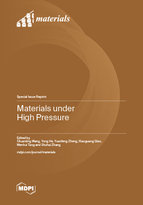Materials under High Pressure
A special issue of Materials (ISSN 1996-1944). This special issue belongs to the section "Advanced Composites".
Deadline for manuscript submissions: closed (10 October 2023) | Viewed by 19735
Special Issue Editors
Interests: reactive materials; high-velocity impact; plastic deformation
Special Issues, Collections and Topics in MDPI journals
Interests: terminal ballistics; high-velocity impact; detonation
Special Issues, Collections and Topics in MDPI journals
Interests: terminal ballistics; reactive materials; shape charge effects
Special Issues, Collections and Topics in MDPI journals
Interests: designing and developing high performance Mg alloys; severe plastic deformation (SPD); strengthening and toughening of Mg alloys; nanoindentation
Special Issues, Collections and Topics in MDPI journals
Interests: equation of state; dynamic behavior of materials
Special Issues, Collections and Topics in MDPI journals
Interests: molecular reaction dynamics of explosive crystal; behavior co-crystals; detonation mechanism
Special Issues, Collections and Topics in MDPI journals
Special Issue Information
Dear Colleagues,
Materials experience a series of interesting changes under extreme high pressure, including flow, plastic deformation, phase transformation, fracture, temperature rise and chemical reactions. High pressure can be generated by die compression, high-velocity impact or explosions. This Special Issue ‘Materials under high pressure’ will focus on the recent research findings on high pressure-related problems in all types of materials. The main topics to be covered include processing technology, state-of-the-art characterization, testing, theoretic modeling and simulation.
We welcome the submission of communications, original research papers and reviews on the following, or related, topics:
- material flow mechanism under high pressure;
- microstructural evolution;
- severe plastic deformation;
- high-velocity impact;
- materials or structures under explosion;
- impact-initiated chemical reactions.
Dr. Chuanting Wang
Prof. Dr. Yong He
Dr. Yuanfeng Zheng
Dr. Xiaoguang Qiao
Prof. Dr. Wenhui Tang
Prof. Dr. Shuhai Zhang
Guest Editors
Manuscript Submission Information
Manuscripts should be submitted online at www.mdpi.com by registering and logging in to this website. Once you are registered, click here to go to the submission form. Manuscripts can be submitted until the deadline. All submissions that pass pre-check are peer-reviewed. Accepted papers will be published continuously in the journal (as soon as accepted) and will be listed together on the special issue website. Research articles, review articles as well as short communications are invited. For planned papers, a title and short abstract (about 100 words) can be sent to the Editorial Office for announcement on this website.
Submitted manuscripts should not have been published previously, nor be under consideration for publication elsewhere (except conference proceedings papers). All manuscripts are thoroughly refereed through a single-blind peer-review process. A guide for authors and other relevant information for submission of manuscripts is available on the Instructions for Authors page. Materials is an international peer-reviewed open access semimonthly journal published by MDPI.
Please visit the Instructions for Authors page before submitting a manuscript. The Article Processing Charge (APC) for publication in this open access journal is 2600 CHF (Swiss Francs). Submitted papers should be well formatted and use good English. Authors may use MDPI's English editing service prior to publication or during author revisions.
Keywords
- advanced metallic alloys
- structural composites and hybrid materials
- materials for extreme in-service conditions
- multifunctional structural materials
- high pressure
- impact
- explosion
- plastic deformation
- microstructural evolution
- chemical reaction
- equation of state
- characterization
- modeling
- simulation












